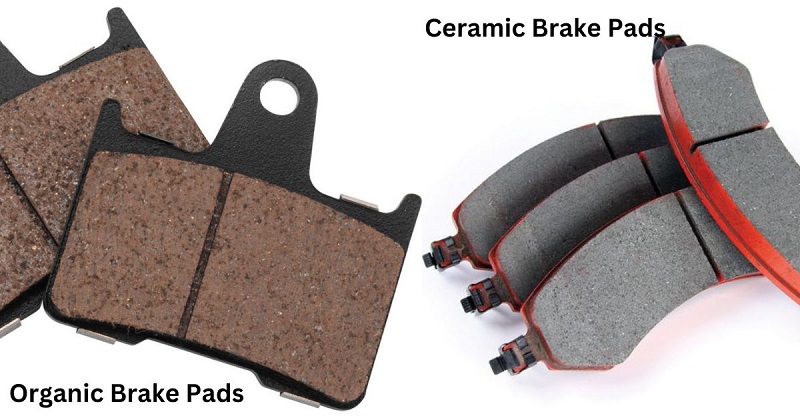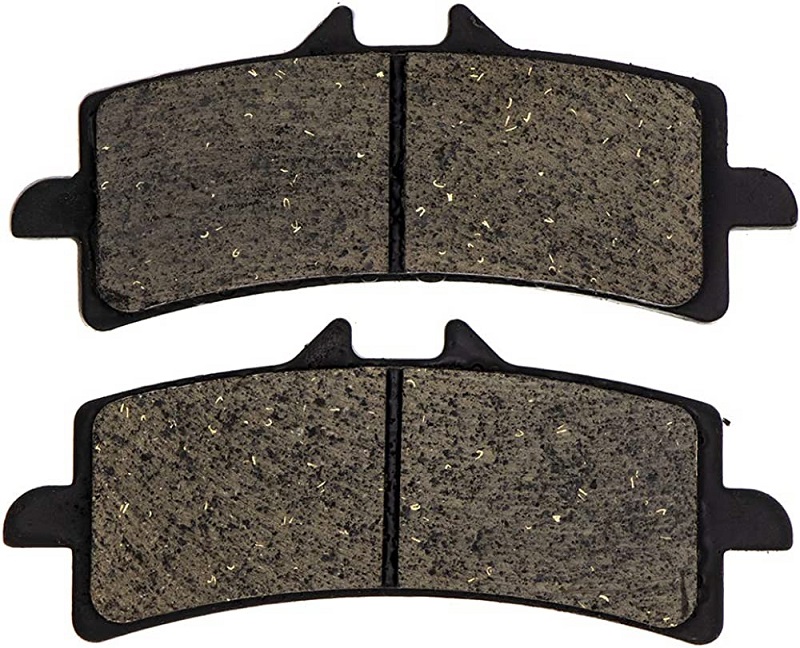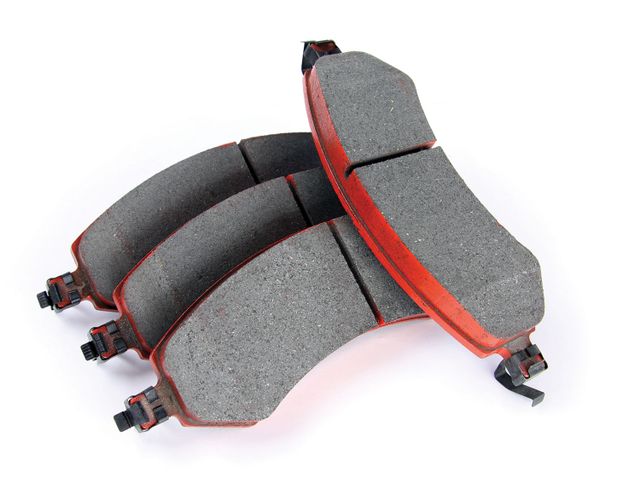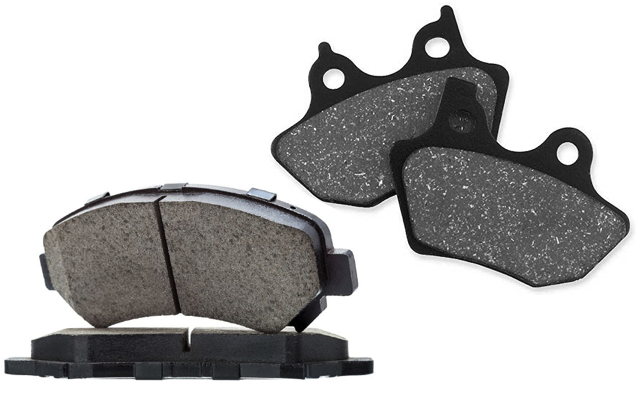When it comes to braking systems, there are a variety of brake pad materials available. Of these, the two most common are organic and ceramic brake pads.
Each type has its own advantages and disadvantages that must be considered before making a choice.
In this blog post, we will discuss the differences between organic brake pads vs ceramic brake pads.
We will examine the various benefits and drawbacks of each material in order to help you make an informed decision before replacing your brakes.
Organic Brake Pads vs Ceramic: A Brief Overview

When it comes to choosing brake pads for your vehicle, there are several options available in the market. Organic and ceramic brake pads are two popular choices, but what sets them apart?
The main difference between organic and ceramic brake pads is their composition. Organic brake pads are made of a mixture of materials like rubber, glass, carbon fibers, and others while ceramic brake pads are made up of dense ceramic material.
Organic brake pads have been around for decades and provide reliable stopping power with less noise than metallic or semi-metallic alternatives.
They also produce less dust than other types of brake pads which makes them an ideal choice for daily driving.
On the other hand, ceramic brakes offer superior performance under high-speed conditions due to their ability to dissipate heat more effectively than organic brakes.
Ceramic brakes also last longer than organic ones because they can withstand consistent use without wearing down as quickly.
Organic Brake Pads

Organic brake pads are a type of brake pad that is designed to provide reliable stopping power while minimizing wear and tear on the braking system.
Unlike other types of brake pads, which may be made from ceramic, metallic, or semi-metallic materials, organic brake pads are composed primarily of natural fibers like rubber and Kevlar.
These materials make organic brake pads an ideal choice for drivers who want to reduce noise, dust, and vibrations when braking.
One of the key advantages of using organic brake pads is their ability to provide consistent stopping power even in wet conditions.
This is because they tend to produce less heat than other types of brake pads, which can help prevent them from slipping or losing traction on wet roads.
Additionally, since organic brake pads are typically softer than other types of brake pads, they tend to wear down more quickly than metallic or ceramic options.
How Organic Brake Pads Work
Organic brake pads are a popular choice among drivers who prioritize safety and environmental consciousness. These brake pads are made from natural materials such as rubber, Kevlar, and fiber.
Unlike metallic or ceramic brake pads, organic brake pads do not contain harmful metals such as copper and lead.
So how do organic brake pads work? When you press the brake pedal, the calipers of your car’s braking system will apply pressure to the rotor.
This pressure creates friction between the rotor and the brake pads, which slows down or stops your vehicle. Organic brake pads use their unique composition to create this friction.
As you apply pressure to the brakes, the rubber and other materials in the pad compress together to form a solid contact with the rotor surface. Organic brake pads also function well in different driving conditions such as wet roads or extreme temperatures.
Organic Brake Pads Pros and Cons
Organic brake pads are an increasingly popular choice for automobile owners, but there are pros and cons to consider.
Understanding the advantages and disadvantages of these unique components can help you decide whether they are a good fit for your vehicle.
Organic brake pads provide improved braking performance compared to standard pads, but they also require more frequent maintenance and have a shorter lifespan.
It’s important to weigh both the advantages and disadvantages before making a decision to install organic brake pads on your car.
Advantages of Organic Brake Pads
Organic brake pads have been gaining popularity among car owners due to their numerous benefits. The first advantage of organic brake pads is that they are made from natural materials such as rubber, glass, and resin.
This means that they are environmentally friendly and do not contain any harmful chemicals or metals like asbestos that can cause health problems when inhaled.
Another pro of organic brake pads is that they produce less noise and vibration compared to other types of brake pads.
This makes them a great choice for drivers who prioritize comfort during driving. In addition, organic brake pads are also known to have better stopping power than ceramic or semi-metallic brakes on wet surfaces.
This is because the material used in making these brakes has excellent gripping capabilities even when it’s raining or snowing.
Finally, one more benefit of organic brake pads is that they tend to be more affordable than other types of brakes on the market.
Disadvantages of Organic Brake Pads
Organic brake pads are often touted as being better for the environment and more affordable than their metallic counterparts.
However, there are several significant disadvantages to using organic brake pads that should be considered before making a decision.
The first disadvantage of using organic brake pads is their shorter lifespan. Organic materials tend to wear down faster than metallic ones, which means they will need to be replaced more frequently.
This can lead to increased maintenance costs over time, which may negate any savings you initially saw from choosing organic brake pads.
Another disadvantage of organic brake pads is their performance in extreme conditions. When exposed to high temperatures or heavy loads, organic materials tend to break down more quickly than metallic ones.
This can result in reduced stopping power and even dangerous braking situations in certain circumstances. Finally, some drivers have reported issues with noise and vibration when using organic brake pads.
Ceramic Brake Pads

Ceramic brake pads are a type of brake pad used in automotive braking systems. They are made using ceramic fibers and non-ferrous filler materials, which make them more durable and resistant to heat than traditional metal or organic brake pads.
Ceramic brake pads offer several advantages over their counterparts, including improved stopping power, reduced noise levels, and longer lifespan.
One of the most significant benefits of ceramic brake pads is their ability to dissipate heat effectively. When brakes get too hot, they can lose effectiveness, leading to longer stopping distances and reduced safety on the road.
Ceramic material has a much higher thermal capacity than metals or organics, meaning it can absorb more heat without losing performance.
As a result, ceramic pads provide better braking power even under heavy use conditions such as high-speed driving or towing. Another advantage of ceramic brake pads is their quiet operation.
How Ceramic Brake Pads Work
Ceramic brake pads are one of the most popular types of brake pads available in the market. They are commonly used in high-performance vehicles due to their ability to produce less noise, dust, and wear on the rotor. But how do ceramic brake pads work?
Ceramic brake pads use a combination of ceramic fibers and other materials such as copper fibers, graphite, or Kevlar. These materials are compressed into a dense pad that sits inside the caliper.
When you apply pressure to the brakes, it forces the caliper to squeeze down on the rotor with two pads (one on each side). The friction between these components allows your vehicle to slow down and eventually come to a stop.
Ceramic brake pads work by transforming kinetic energy into thermal energy through frictional forces generated during braking.
Ceramic Brake Pads Pros and Cons
If you’re a car owner, then you know how important it is to keep your vehicle in good condition. One of the most critical components of any vehicle is its braking system.
The type of brake pads you use has a direct impact on how well your brakes perform and how much maintenance they require.
Ceramic brake pads are becoming increasingly popular amongst drivers due to their many benefits. However, like any product, there are also some downsides to consider.
In this article, we’ll explore the pros and cons of ceramic brake pads so that you can make an informed decision about whether or not they’re right for your vehicle. We’ll discuss topics such as durability, noise level, dust generation, stopping power, and more.
Advantages of Ceramic Brake Pads
Ceramic brake pads have been gaining popularity in the automotive industry and for good reason. These brake pads use a ceramic material to provide superior stopping power and a longer lifespan compared to traditional metallic brake pads.
Here are some of the pros of ceramic brake pads.
Firstly, ceramic brake pads generate less dust than their metallic counterparts. This is great news for those who like to keep their cars clean since there will be less mess left on your wheels and exterior surfaces.
Additionally, the reduced dust also means that your braking system stays cleaner, which can help extend its lifespan.
Secondly, ceramic brake pads offer better performance in extreme temperatures. Whether you are driving on a hot summer day or through snowy conditions in winter, ceramic brakes remain stable and reliable under any temperature condition.
The high heat resistance of these brakes makes them ideal for high-performance vehicles that demand consistent braking power even under heavy usage.
Disadvantages of Ceramic Brake Pads
Ceramic brake pads have gained popularity in the brake pad market due to their superior performance and longevity.
However, like every other product, there are disadvantages associated with ceramic brake pads that consumers should be aware of before making a purchase.
One of the major cons of ceramic brake pads is their high cost compared to other types of brake pads. This can be a significant disadvantage for individuals on a tight budget or those who do not want to spend too much on their car maintenance.
Another disadvantage of ceramic brake pads is that they tend to produce more noise than other types of brake pads, especially when cold.
This can be annoying for drivers who prefer a quiet ride or for those living in residential areas where noisy brakes may cause disturbance to neighbors. Additionally, ceramic brake pads require a longer break-in period than most other types of brake pads before reaching optimal performance levels.
Organic Brake Pads vs Ceramic: The Comparison

When it comes to choosing the right brake pad for your vehicle, it can be tricky to know which one is best. Organic and ceramic brake pads are two popular choices for many drivers, but what are the differences between them?
In this section, we will discuss the similarities and differences between organic and ceramic brake pads, their benefits and drawbacks, as well as which type may be better for your needs.
1. Brake Performance
When it comes to brake pads for your vehicle, two of the most popular options are organic and ceramic. But what exactly is the difference between the performance of these two types of brake pads?
Let’s take a closer look.
Organic brake pads are made from a mix of fibers and binding agents, such as rubber, Kevlar, or glass. They tend to be softer than ceramic pads and thus produce less noise when braking.
However, they also have a shorter lifespan and may not perform as well in extreme heat or under heavy loads.
On the other hand, ceramic brake pads are made from a mixture of ceramic materials and metal fibers. They offer better performance in high temperatures and under heavy loads, making them a popular choice for sports cars or vehicles used for towing. Additionally, they tend to last longer than organic pads but can be more expensive upfront.
2. Durability
When it comes to selecting brake pads, the two most common options are organic and ceramic. While both serve the same purpose of slowing down your vehicle, they differ in terms of their composition and durability.
The biggest difference between the two is that organic brake pads are made from natural materials like rubber, glass, and resin. In contrast, ceramic brake pads are made from a mixture of ceramic fibers, metal shavings, and bonding agents.
In terms of durability, ceramic brake pads tend to last longer than organic ones due to their harder material composition.
Ceramic brake pads can withstand high temperatures without degrading or breaking down quickly. Additionally, they produce less dust compared to organic ones which makes them ideal for vehicles that require minimal maintenance or have expensive wheels that need protection from dust buildup.
3. Noise and dust
Choosing the right brake pads can be a daunting task for car owners. When it comes to selecting between organic and ceramic brake pads, one of the most frequently asked questions is which one produces more noise and dust?
Well, the answer might surprise you. Organic brake pads are made up of materials like rubber, glass, Kevlar, and resin.
These types of brake pads produce more dust than their ceramic counterparts because they wear down quickly. Moreover, they tend to make less noise during braking compared to ceramics.
On the other hand, ceramic brake pads are made up of non-ferrous fibers bonded with resins and fillers under high pressure and temperature.
They have excellent stopping power even in high temperatures but tend to produce more noise than organic ones due to their harder composition.
However, they produce significantly less dust than organic ones due to their low levels of metallic fibers used in their composition.
4. Cost
When it comes to replacing brake pads on a vehicle, one of the most common questions that car owners ask is what is the difference between the cost of organic brake pads and ceramic brake pads.
Brake pads are an essential component in any vehicle’s braking system, as they are responsible for helping your car come to a stop when you apply pressure on the brakes.
However, not all brake pads are created equal and their costs can vary depending on factors such as material used, brand, and durability.
Organic brake pads are made from non-metallic materials such as rubber, glass, Kevlar, or resin that offer excellent stopping power at lower speeds.
They tend to be less expensive than ceramic brake pads but have shorter lifespans due to their softer composition which leads to faster wear and tear.
Choosing the Right Brake Pads: The Factors to Consider
Choosing the right brake pads for your vehicle is an important decision that should not be taken lightly. It can determine the quality of your braking performance, as well as you and your passengers’ safety.
Different factors need to be taken into account when choosing the right brake pads, including the type of vehicle, driving conditions, and budget.
I. Personal Preferences
When it comes to the safety of your vehicle, brakes are undoubtedly one of the most crucial components. And with so many options available, choosing the right brake pads can be a daunting task.
Two popular choices for brake pads are organic and ceramic. While both offer pros and cons, considering personal preferences is essential in deciding which type of pad would best suit your needs.
Firstly, organic brake pads are made from natural materials such as rubber, glass, and resin. They provide excellent stopping power at lower speeds and produce less noise than their ceramic counterparts.
However, they tend to wear out quickly and produce more dust than ceramic pads. On the other hand, ceramic brake pads are made from a mix of copper fibers and ceramic materials that offer durability and strength while reducing dust production. Ceramic brakes perform better at high speeds but can be noisier than organic ones.
II. Type of Vehicle
When it comes to brake pads, there are two main types to choose from: organic and ceramic. While both have their benefits and drawbacks, one important factor to consider when choosing between them is the type of vehicle you drive.
The weight, size, and use of your vehicle can all affect which type of brake pad is best for you.
For lighter vehicles such as sedans or coupes that aren’t used for heavy-duty tasks like towing or hauling, organic brake pads can be a good choice.
These pads are typically made from materials like rubber, glass, and Kevlar fibers which provide excellent stopping power without causing excessive wear on the rotors. They also tend to be quieter than ceramic pads and produce less dust.
On the other hand, if you own a larger vehicle like an SUV or truck that sees frequent use in heavy-duty applications, ceramic brake pads may be the better option.
III. Type of Driving
When it comes to choosing between organic and ceramic brake pads, there are several factors that a driver should consider. One of the most important considerations is the type of driving you’ll be doing.
Different types of driving can put different stresses on your brakes, which can affect their performance and longevity.
For instance, if you do a lot of stop-and-go city driving or drive in hilly areas, you may want to consider organic brake pads. Organic brake pads are made from materials like rubber, carbon, and Kevlar.
They tend to be softer than ceramic pads, which means they’re better at absorbing heat and providing good stopping power when braking repeatedly over short distances.
However, organic brake pads tend to wear out faster than ceramic pads and may not perform as well in high-speed situations.
Organic Brake Pads vs Ceramic: What’s the Difference? (Summary)
Organic brake pads offer a good balance between performance and affordability, while ceramic brake pads offer superior performance but at a higher price.
Organic pads are also quieter than their ceramic counterparts. However, they may wear out faster due to their softer composition.
Ceramic pads have the advantage of being extremely durable and often come with a longer warranty period. Ultimately, the choice between organic or ceramic brake pads should be based on one’s driving style and budget.
Other Blog Posts
